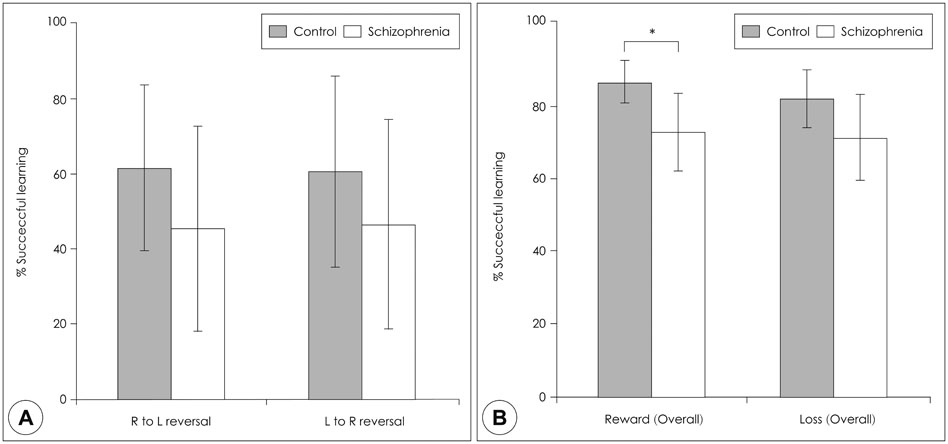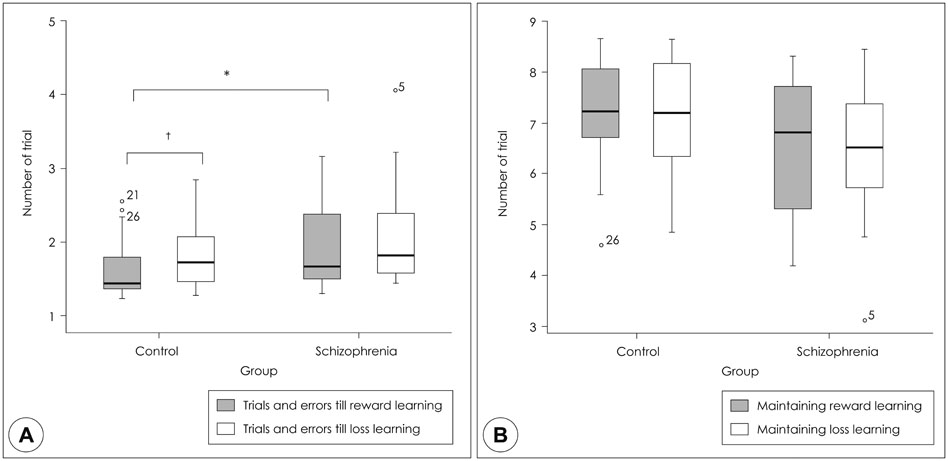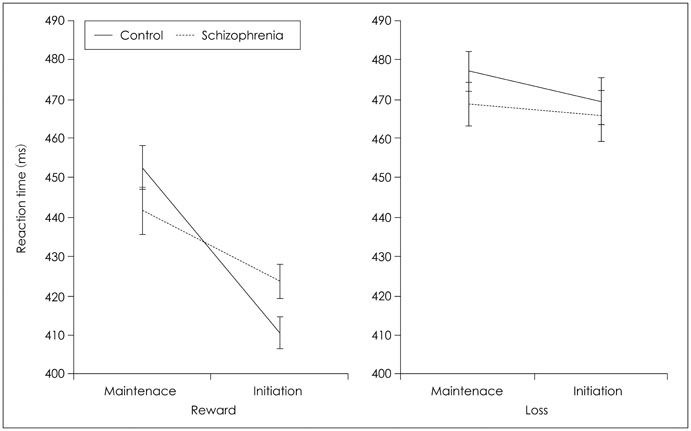Korean J Schizophr Res.
2012 Oct;15(2):59-65. 10.16946/kjsr.2012.15.2.59.
The Characteristics of Associative Learning of Reward Approach and Loss Aversion in Schizophrenia
- Affiliations
-
- 1Department of Psychiatry, Myongji Hospital, Kwandong University College of Medicine, Goyang, Korea. eihpark@gmail.com
- 2Department of Psychiatry, Yonsei University College of Medicine, Seoul, Korea.
- 3Institute of Behavioral Science, Yonsei University College of Medicine, Seoul, Korea.
- KMID: 2288281
- DOI: http://doi.org/10.16946/kjsr.2012.15.2.59
Abstract
OBJECTIVES
Schizophrenia patients have deficits of prediction and learning related to dopaminergic dysfunction. It is hypothesized that there would be different characteristics in associative learning of reward approach and loss aversion between controls and patients.
METHODS
Participants were 23 healthy participants and 20 out-patients fulfilling criteria for schizophrenia according DSM-IV-TR. Using a monetary incentive contingency reversal task, successful learning rates, numbers of trials and errors till learning, numbers of trials of maintaining learning, response times were measured. Characteristics of learning were compared between controls and patients.
RESULTS
Physical anhedonia and PANSS negative symptom scores correlated with the number of trials while loss aversion was maintained. Overall correct response rates were decreased in patient group, particularly during reward approach learning. Patients required more trials and errors to learn reward approach than controls. There were no significant differences in learning performance and reaction times between groups during loss avoidance learning.
CONCLUSION
These results support previous reports of deficits in reward-driven learning in schizophrenia. However, anhedonia and negative symptoms were associated with the preserved function of loss avoidance learning.
MeSH Terms
Figure
Reference
-
1. Strauss GP, Frank MJ, Waltz JA, Kasanova Z, Herbener ES, Gold JM. Deficits in positive reinforcement learning and uncertainty-driven exploration are associated with distinct aspects of negative symptoms in schizophrenia. Biol Psychiatry. 2011. 69:424–431.
Article2. Berridge KC, Robinson TE. Parsing reward. Trends Neurosci. 2003. 26:507–513.
Article3. Waltz JA, Frank MJ, Robinson BM, Gold JM. Selective reinforcement learning deficits in schizophrenia support predictions fromcomputational models of striatal-cortical dysfunction. Biol Psychiatry. 2007. 62:756–764.
Article4. Prentice KJ, Gold JM, Buchanan RW. The Wisconsin Card Sorting impairment in schizophrenia is evident in the first four trials. Schizophr Res. 2008. 106:81–87.
Article5. Kapur S. Psychosis as a state of aberrant salience: a framework linking biology, phenomenology, and pharmacology in schizophrenia. Am J Psychiatry. 2003. 160:13–23.
Article6. Frank MJ. Schizophrenia: a computational reinforcement learning perspective. Schizophr Bull. 2008. 34:1008–1011.
Article7. Gard DE, Kring AM, Gard MG, Horan WP, Green MF. Anhedonia in schizophrenia: distinctions between anticipatory and consummatory pleasure. Schizophr Res. 2007. 93:253–260.
Article8. Gold JM, Waltz JA, Prentice KJ, Morris SE, Heerey EA. Reward processing in schizophrenia: a deficit in the representation of value. Schizophr Bull. 2008. 34:835–847.
Article9. Wächter T, Lungu OV, Liu T, Willingham DT, Ashe J. Differential effect of reward and punishment on procedural learning. J Neurosci. 2009. 29:436–443.
Article10. Association AP. Diagnostic and statistical manual of mental disorders: DSM-IV-TR. 2000. Washington: American Psychiatric Publishing.11. Raven J, Court J, Raven J. Raven-Matrizen-test standard progressive matrices. 1988. Weinheim: Test Gesellschaft.12. Chapman LJ, Chapman JP, Raulin ML. Scales for physical and social anhedonia. J Abnorm Psychol. 1976. 85:374.
Article13. Watson D, Clark LA, Tellegen A. Development and validation of brief measures of positive and negative affect: the PANAS scales. J Pers Soc Psychol. 1988. 54:1063.
Article14. Min BB, Oh HS, Lee JY. Temperament and Character Inventory(TCI) Manual. 2007. Seoul: Maumsarang.15. Yi JS, Ahn YM, Shin HK, An SK, Joo YH, Kim SH, et al. Reliability and Validity of the Korean Version of the Positive and Negative Syndrome Scale. J Korean Neuropsychiatr Assoc. 2001. 40:1090–1105.16. van der Gaag M, Hoffman T, Remijsen M, Hijman R, de Haan L, van Meijel B, et al. The five-factor model of the Positive and Negative Syndrome Scale II: a ten-fold cross-validation of a revised model. Schizophr Res. 2006. 85:280–287.
Article17. Blanchard JJ, Mueser KT, Bellack AS. Anhedonia, positive and negative affect, and social functioning in schizophrenia. Schizophr Bull. 1998. 24:413–424.
Article18. Waltz JA, Gold JM. Probabilistic reversal learning impairments in schizophrenia: further evidence of orbitofrontal dysfunction. Schizophr Res. 2007. 93:296–303.
Article19. Lee Y, Kim YT, Seo E, Park O, Jeong SH, Kim SH, et al. Dissociation of emotional decision-making from cognitive decision-making in chronic schizophrenia. Psychiatry Res. 2007. 152:113–120.
Article20. Danion JM, Gokalsing E, Robert P, Massin-Krauss M, Bacon E. Defective relationship between subjective experience and behavior in schizophrenia. Am J Psychiatry. 2001. 158:2064–2066.
Article21. Wise RA. Dopamine, learning and motivation. Nat Rev Neurosci. 2004. 5:483–494.
Article22. Arnt J. Pharmacological specificity of conditioned avoidance response inhibition in rats: inhibition by neuroleptics and correlation to dopamine receptor blockade. Acta Pharmacol Toxicol (Copenh). 1982. 51:321–329.
Article23. Borison R. The role of cognition in the risk-benefit and safety analysis of antipsychotic medication. Acta Psychiatr Scand Suppl. 1996. 94:5–11.
Article
- Full Text Links
- Actions
-
Cited
- CITED
-
- Close
- Share
- Similar articles
-
- Personality Characteristics and Insight Acquisition in Schizophrenia
- Reward Learning in Euthymic Patients with Bipolar Disorder Using a Probabilistic Reward Task
- Smoking as an Addictive Disorder
- Performance of Verbal Memory Tasks in Patients with Schizophrenia
- Effects of Add-on Ramelteon on Cognitive Impairment in Patients with Schizophrenia: An Open-label Pilot Trial




